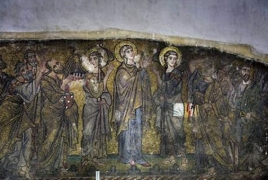
After two years of painstaking work, experts have completed the initial phase of a delicate restoration project at the Church of the Nativity, giving a much-needed face-lift to one of Christianity's holiest sites, the Associated Press reports.
The project, partially funded by the Palestinians and conducted by a team of Palestinian and international experts, is the biggest restoration at the iconic church in some 600 years. The removal of centuries of dust has left Crusader-era mosaics sparkling in sunlight filtering through brand new windows. Structural repairs on the fragile rooftop and windows have been completed and art treasures have been returned to their delicate elegance.
Although the Palestinians are overwhelmingly Muslim, they consider the church a national treasure and one of their most visited tourist sites, and President Mahmoud Abbas has been actively involved in the project.
Ziad al-Bandak, who leads the Palestinian committee in charge of the restoration, calls what has been accomplished so far nothing short of "revolutionary."
The Church of the Nativity, located in the biblical West Bank town of Bethlehem, was built by Saint Helena in the 4th century over the grotto where the Virgin Mary is said to have given birth to Jesus. Despite its spiritual significance, the church was neglected for centuries and is listed as endangered by UNESCO, the United Nations cultural agency. Until two years ago, rain leaked through the severely damaged rooftop, threatening to harm priceless artworks inside, the AP says.
Then, in 2013, the Palestinian Authority, the internationally backed self-rule government, took the lead in financing the restoration. The rest has come from the Palestinian private sector, the Roman Catholic, Greek Orthodox and Armenian churches and other countries. Al-Bandak said nearly $8 million has already been spent.
The renovation is being conducted by a joint team of engineers, restoration experts and workers — Palestinians as well as Italians from "Piacenti," a firm which specializes in the renovation of historical sites and has worked on dozens of villas, palaces, churches and monasteries in Italy and Russia.
Over the past two years, specialists have replaced the most damaged of the ancient wood beams of the rooftop and put up a new cover. They also installed new wooden framed windows that prevent water infiltration. For the first time in almost 1,000 years the thousands of fine mosaics' tiles have been retouched.
While experts are still carrying out work 10 meters above ground, visitors and pilgrims will have to wait until the end of 2016 before being able to admire the winged creatures and brightly colored mosaics that have been brought back to rare brilliance.
The full restoration will continue in phases and is expected to take at least another three years.

